
The mosaic disease on cassava has basically been
kept under control
Accordingly, to promote the prevention and control
of mosaic disease and fall armyworms on corn plants, the Chairman of the
provincial People’s Committee asked the provincial Department of Agriculture and
Rural Development to host and coordinate with concerned departments and sectors
and localities to monitor the cultivation process of corn and cassava to set
directions on varieties, harvest time, and farming methods against mosaic
disease and fall armyworms on cassava; enhance inspection to early find out the
cassava-growing areas infected with mosaic disease and fall armyworms on cassava
and provide preventive measures according to Plant Protection Department’s
technical process of prevention and control of cassava mosaic and fall
armyworms; direct the agricultural promotion system to focus on disseminating
propaganda and giving farmers training and guidance on prevention and control
measures; conduct quick testing of types of plant protection products that work
for fall armyworms as a basis to give farmers warnings; investigate to find out
types of cassava with a substantial resistance to mosaic disease and types of
corn with a great resistance to fall armyworms and show farmers how to replace
badly-infected varieties; continue to apply the production models of
free-disease cassava varieties to ensure that disease-free varieties are put
into production.

Fall armyworms continue to cause damage to some
corn-growing areas in the province
Also, the Chairman of the provincial People’s
Committee directed the People’s Committees of districts and cities to further
disseminate propaganda information and how to prevent and control the mosaic
disease and fall armyworms of the Plant Protection Department; warn farmers not
to use the cuttings of cassava that originate from Tay Ninh, where local
authorities have announced outbreaks and those infected with diseases, not to
plant cassava varieties HL–S11 and KM149 that are heavily infected, plant
disease-free varieties or those less infected with KM94; and prevent the
transmission of mosaic disease by using traps to kill spiraling whiteflies.
Also, the areas with the risk of spiraling whitefly outbreaks need to be sprayed
with plant protection products Dinotefuran or Pymetrozine and farmers are
recommended to plant alternative crops but tobacco, tomato, Vietnamese
eggplants, ca dua, bottle gourds, gourds, chili, and so on.
Also, it is urgent to call for farmers to destroy
cassava stems, leaves, and other post-harvest plants in infected areas;
strengthen inspection and strictly control of the transport of cassava leaves
and stems from infected to uninfected areas and place a ban on trading infected
cassava varieties. Simultaneously, it is necessary to investigate to early
detect the cassava-growing areas infected with mosaic disease and fall armyworms
causing harms to corn plants and show farmers how to seriously adopt preventive
measures; establish corn or cassava clubs or production groups to exchange
experience in the prevention and control of mosaic disease and fall armyworms on
corn.
According to the provincial Department of
Agriculture and Rural Development, to prevent cassava mosaic the Provincial
Plant Protection has introduced 4 models of managing disease-free cassava
varieties in Xuan Loc district (2 models) and in Long Thanh district (2 models)
on KM 140 and KM 225 varieties on an area of 92 ha.
All these models have been applied with synchronous
measures like using yellow sticky traps to control spiraling whiteflies and
spray plant protection products to prevent their outnumbering appearance, have
samples of whiteflies and cassava before and after harvest time to determine
infected cassava varieties.
Also, during the testing process the cassava plants
of 4 models have grown and developed well and the effective level of yellow
sticky traps have varied from 10 to 214 flies per trap and no cassava plants
have been found to be infected with mosaic disease. Up to now, farmers have
harvested 59 hectares with an average yield of 26-33 tons per ha and this source
of disease-free cassava is expected to be provided for production activities.
Duy Minh (L. Van)